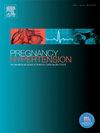产后口服速尿对产后再入院及血压趋势的影响。
IF 2.9
4区 医学
Q2 OBSTETRICS & GYNECOLOGY
Pregnancy Hypertension-An International Journal of Womens Cardiovascular Health
Pub Date : 2025-01-29
DOI:10.1016/j.preghy.2025.101199
引用次数: 0
摘要
背景:在随机对照试验中,产后口服速尿可缩短高血压消退的时间。需要进一步的研究来确定速尿在常规临床实践中的影响。目的:评估呋塞米对妊娠期高血压疾病患者产后高血压和再入院率的影响。研究设计:2021年10月至2022年4月在单一机构对产后妊娠高血压疾病患者进行前瞻性队列研究。患者被纳入远程产后血压监测程序(RPM)作为标准护理。所有妊娠期高血压和先兆子痫患者均按方案实施产后5天口服呋塞米。数据采集至产后6周。排除标准包括年龄小于18岁、单独患有慢性高血压且未合并先兆子痫的患者以及未同意数据收集的患者。主要结局为产后6周内再入院。次要结果是这六周的血压值。高血压定义为收缩压≥140 mmHg或舒张压≥90 mmHg的任何血压值。结果:总体而言,545名患者在研究期间纳入了RPM计划,其中306名患者同意收集数据,258名患者在符合所有纳入标准后最终纳入,没有排除。其中,203名患者接受了速尿治疗。总体而言,47.7%的患者有妊娠期高血压,40.3%的患者有伴有或不伴有严重特征的先兆子痫,12.0%的患者合并有或不伴有严重特征的先兆子痫。总的来说,24.2%的患者出院时服用了除速尿外的降压药物。总再入院率为13.2%。口服呋塞米的患者与未口服呋塞米的患者之间没有差异(12.8% vs 14.6%, p = 0.74)。两组在产后一周的高血压发生率无显著差异(32.8%[口服呋塞米]vs 36.2%[不服用呋塞米],p = 0.66)。6周随访时,速尿组舒张压较低(74 [69,81]vs 82 [76,89];P = 0.02)。结论:加用速尿不能改善产后第一周的血压控制,也不能减少再入院率。然而,在接受速尿治疗的患者中,舒张压在6周的随访中呈下降趋势。本文章由计算机程序翻译,如有差异,请以英文原文为准。
Effect of postpartum oral furosemide use on postpartum readmissions and blood pressure trends
Background
Oral furosemide postpartum improves the time to hypertension resolution in randomized control trials. Further investigation is needed to determine the impact of furosemide in routine clinical practice.
Objective
Real world study to assess impact of furosemide on rates of postpartum hypertension and readmissions for patients with hypertensive disorders of pregnancy.
Study Design
A prospective cohort study of postpartum patients with hypertensive disorders of pregnancy at a single institution between October 2021 and April 2022. Patients were enrolled in the remote postpartum blood pressure monitoring program (RPM) as standard of care. Use of oral furosemide for 5 days postpartum was implemented per protocol for all patients with gestational hypertension and preeclampsia. Data was obtained until six weeks postpartum. Exclusion criteria included age less than 18 years old, patients with chronic hypertension alone without superimposed preeclampsia, and patients who did not provide consent for data collection. The primary outcome was hospital readmission within six weeks postpartum. The secondary outcome was blood pressure values across those six weeks. Hypertension was defined as any blood pressure value with SBP ≥ 140 mmHg or DBP ≥ 90 mmHg.
Results
Overall, 545 patients were enrolled in the RPM program during the study period, 306 of them consented to data collection and 258 patients were ultimately included after meeting all inclusion criteria with no exclusions. Of these, 203 patients received furosemide. Overall, 47.7 % of patients had gestational hypertension, 40.3 % of patients had preeclampsia with or without severe features, and 12.0 % of patients had superimposed preeclampsia with or without severe features. In total, 24.2 % of patients were discharged home on an antihypertensive medication in addition to furosemide. The overall rate of readmission was 13.2 %. There was no difference between patients who received oral furosemide versus those who did not (12.8 % vs 14.6 %, p = 0.74). Rates of hypertension at the one-week postpartum visit between those two groups did not differ significantly (32.8 % [oral furosemide] vs 36.2 % [no furosemide], p = 0.66). Diastolic blood pressures at the six-week follow-up visit were lower in the furosemide group (74 [69,81] vs 82 [76,89]; p = 0.02) among patients registered to care who completed the six-week visit.
Conclusion
The addition of furosemide did not result in improved blood pressure control by the first week postpartum or fewer hospital readmissions. However, diastolic blood pressure trended lower at the six-week visit in patients who received furosemide.
求助全文
通过发布文献求助,成功后即可免费获取论文全文。
去求助
来源期刊

Pregnancy Hypertension-An International Journal of Womens Cardiovascular Health
OBSTETRICS & GYNECOLOGYPERIPHERAL VASCULAR-PERIPHERAL VASCULAR DISEASE
CiteScore
4.90
自引率
0.00%
发文量
127
期刊介绍:
Pregnancy Hypertension: An International Journal of Women''s Cardiovascular Health aims to stimulate research in the field of hypertension in pregnancy, disseminate the useful results of such research, and advance education in the field.
We publish articles pertaining to human and animal blood pressure during gestation, hypertension during gestation including physiology of circulatory control, pathophysiology, methodology, therapy or any other material relevant to the relationship between elevated blood pressure and pregnancy. The subtitle reflects the wider aspects of studying hypertension in pregnancy thus we also publish articles on in utero programming, nutrition, long term effects of hypertension in pregnancy on cardiovascular health and other research that helps our understanding of the etiology or consequences of hypertension in pregnancy. Case reports are not published unless of exceptional/outstanding importance to the field.
 求助内容:
求助内容: 应助结果提醒方式:
应助结果提醒方式:


